‘March of the Elephants’ – Serengeti, Tanzania
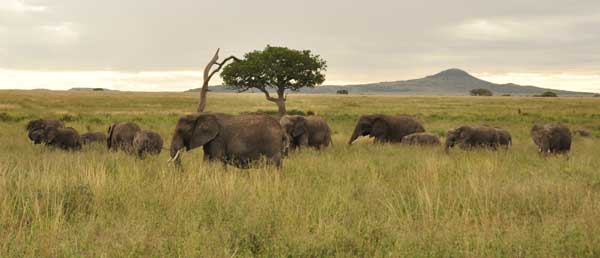
One of innumerable herds of elephants encountered on our Serengeti Safari (including our campsite)…

One of innumerable herds of elephants encountered on our Serengeti Safari (including our campsite)…
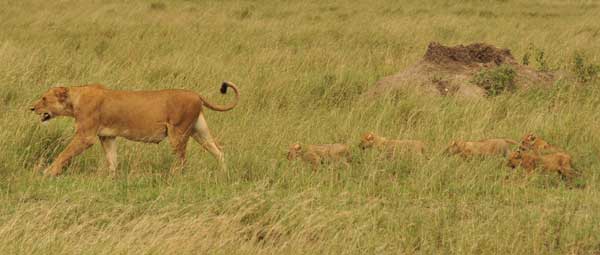
We came across a pride of more than 20 lions feeding on a buffalo. The cubs just kept appearing!
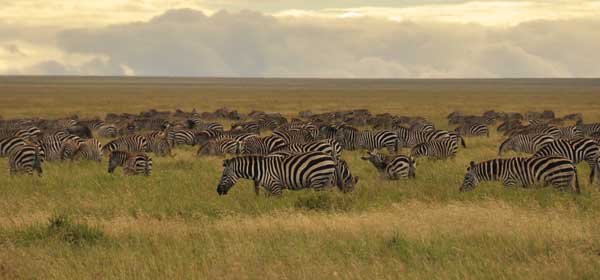
The endless plains of the Serengeti – where literally hundreds of thousands of animals roam!
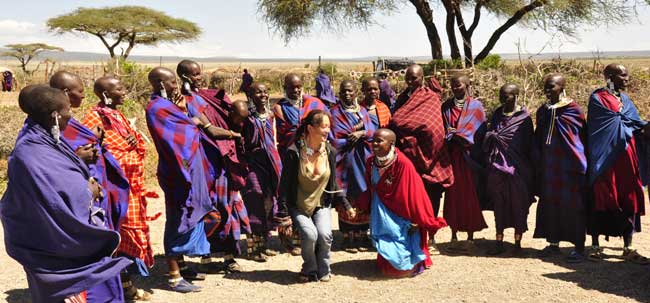
Megumi participating in a welcome ceremony at a Masai village, just outside Ngorongoro crater!
![‘Hotel Heine’, Kenya After the travails of overlanding, we arrived in Nairobi, some 2 days behind schedule and on a bus that was 7 hours late – a […]](http://meltingplots.com/wp-content/uploads/2010/05/Flamingo1.jpg)
After the travails of overlanding, we arrived in Nairobi, some 2 days behind schedule and on a bus that was 7 hours late – a cumulative African delay the result of crossing Tanzania by land from Malawi. Arriving in downtown Nairobi (Nai-robbery as the place is affectionately known) at a bus stand at 2am in is certainly not something any guidebook recommends. One of the toughest cities in Africa, stories of high crime abound – kidnapping, robbery and much worse. The border crossing at night from Kenya to Tanzania at night had already been an interesting experience. Midway along a 6 hour apology for a dirt road, that frequently threw you several metres into the air from your seat; the bus drops you off and proceeds through to the other side of immigration. You are then forced to walk the unlit gauntlet of no-mans land from one immigration centre to the other, while innumerable faces jump out of the dark at you demanding passports or visa payments, telling you your bus is leaving and to follow them or trying to simply change money at ridiculous rates. A hundred scams of chance playing on the nights’ confusion and traveller ignorance, to perhaps extort a profit and distract you from the task at hand.
Hardly unsurprisingly then, that we were incredibly thankful & relieved to be drifting from our usual travelling script and backpacker trail to be actually staying with friends in Nairobi. As a former working colleague of both myself and Megumi; we had known, befriended and shared many trials and tribulations of the professional ilk with James over some 6+ years in Japan. He, his wife Claudia and 9 month gorgeous baby girl, Anais, had recently relocated here from Tokyo; Claudia taking up a job with the UN Environment Programme which is headquartered in Nairobi. After our late night rendezvous with James, we were then given a tour of his recently settled, 5 bedroom house in a UN approved housing compound on the outskirts of the city, complete with several security guards and a maid. With the introduction of our own room & bathroom, a gourmet kitchen, wireless internet and the incredibly generous offer to make ourselves at home for as long as we needed; for us this was more akin to a 5 star hotel than simply crashing at a ‘friends’ place. A breath of fresh air in complete contrast to our recent African adventures, it represented a re-acquaintance with old friends, forgotten luxuries and a sense of home that we had not really experienced since Myanmar some 8 months distant now.
The last year it seems had been quite transformative on all fronts and more than just a reunion, it provided an interesting chance to reflect. Both us, and the Heines’, had experienced huge changes in the last 12 months. For them, having a baby and moving to Kenya was embarking on an exciting, if not daunting new lifestage and career in a new frontier and continent. It was a radical transition that in many ways mirrored our own travel induced evolutions. The joy of seeing James happily transformed into ‘Mr Mom’ and sharing the daily joys and development of the gorgeous Anais with them was immensely rewarding. Equally over the next 2 weeks through Claudia, we were also experienced a fascinating insight into the workings of the UN. The UN complex here employs over 2,000 people and represents the only divisional HQ of the UN based in a developing nation. More akin to a university campus than a set of office’s, it propagates an entire support community in Nairobi. The ever present symphony of cars with red UN diplomatic plates necessitates its own police force and a network of international restaurants, malls, shops and café’s that all supports a lifestyle and international community that we had not experienced since South Africa. While we were there, a large UN divisional biodiversity conference was taking place and Claudia kindly treated us to a tour. Delegates from all the UN countries were in town to meet over several days to share information, research and set / argue policies around key global biodiversity issues. Once hammered out, these policies and guidelines are fed back to their respective governments as global directives and initiatives to influence local executions and bio-diversity programmes. Perusing the display stands showing the latest information, research and policy outlines towards such subjects as biofuels, climate change, indigenous cropping and farming, all provided a fascinating insight into the role the UN is trying to play here. In all, it provided a fantastic perspective and environment that couldn’t be in more contrast with other fellow traveller’s experiences of the city. Suffice to say, that very few people had actually stuck around here for long.
Despite all our other intentions to explore Kenya though, we did not really stray far from this comfortable base. Through the shared passion and perspective imbued by James’ insights, we were able to get some appraisal of the emerging Kenyan & East African mobile, internet and infrastructure space; a glimmer of some of the ideas, opportunities and challenges inherent here. Yet apart from learning, catching up & trading tales, this was also a chance to re-equip, organize and take care of essentials ahead of our next stages of adventure. From the simple joys of being able to upload photo’s, research destinations, book plane tickets (for Iran & Morocco) and buy essentials; to visiting a professional ophthalmologist to sort out my rather serious recurring eye infection and treating ourselves to some gourmet home cooking, we found it quite hard to move. A blissful respite that we remain incredibly grateful for!
The one exception to this was a four day escape a few hours north of Nairobi to do some hiking and explore some of the more accessible and stunning Rift Valley and Lakeside national parks. Via matatu (Kenyan mini-buses) we first made our way to Navaisha, a large lake famous for its flowers and decadent expat behaviour in the 1930’s, made famous by the book “Out of Africa’. Staying at Fisherman’s camp, a beautiful campsite by Lake Navaisha, replete with a local population of captivating black & white Colobus monkeys and surrounded by an electrical fence to keep out the innumerable nocturnal grazing hippo’s; we used this as a base to explore the nearby Hell’s Gate National park on foot. A simple attempt to get some fitness and exercise, while exploring the stunning gorge on Masai land, made famous as sets in the Indiana Jones and TombRaider movies. From Navaisha, we then travelled north to the soda lakes and National Park of Nakuru. Famous for its resident population of 1 million pink flamingos; we chartered a car and circumnavigated the lake as part of a 6 hour tour. As well as a variety of now very familiar African game in the form of buffalo’s, zebra, giraffe, gazelle and hyena, we managed to see more than a dozen white rhino, casually grazing around the edges of the Lake; a fantastic contrast and photographic juxtaposition with the stunning, pink profusion of the flamingos, pelicans and storks – all diligently feeding on the lakes algae.
Reluctantly and indebtedly after a stay of a little more than 2 weeks, we forced ourselves to uproot and move on. We only had 3 weeks left in East Africa before flying to Egypt and had now managed to organize ourselves for a tightly run Tanzanian trifecta to finish – climbing Kilimanjaro the highest mountain in Africa; a safari to explore the Serengeti and Ngorongoro Crater and a final week exploring the exotic Arabic, tropical spice island paradise of the Zanzibar archipelago. With the sorrow of departures, balanced by the excitement of new stages of adventure, we bade a sad farewell to our wonderful hosts, we leave Kenya still largely unexplored, but in doing so, leave plenty of room for a future return…
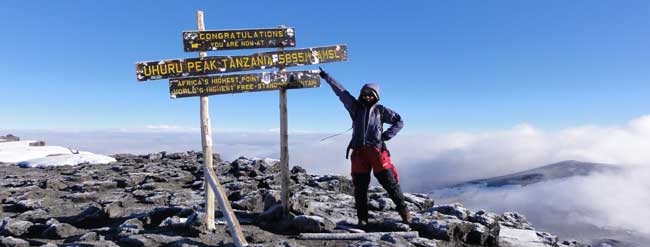
Megumi at the highest peak of Kilimanjaro (5895m), Scott had to turn back on the final ascent with AMS.
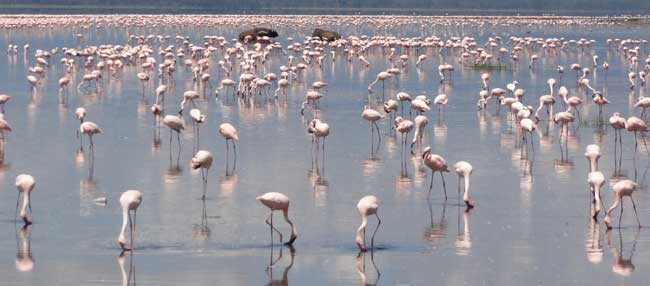
Millions of pink flamingo’s blanket the lake, amongst grazing Rhino’s, Buffalo and Zebra in Lake Nakuru National Park
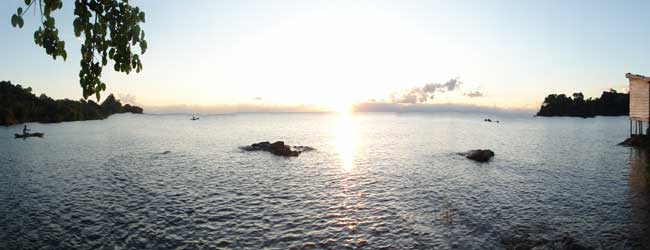
Early morning sunrise over Lake Malawi – Southern Africa’s relaxation central!
![Overlanding Africa When travelling, it seems no matter where you are, you still operate in a kind of bubble. You move in an almost semi-detached observer capacity […]](http://meltingplots.com/wp-content/uploads/2010/05/BusTop.jpg)
When travelling, it seems no matter where you are, you still operate in a kind of bubble. You move in an almost semi-detached observer capacity to your surroundings, unable to see or experience things truly as the locals do. Insulated by your bank balance perhaps, the knowledge of alternative options or simply that you are merely ‘passing through’ and have a ticket out; there are a thousand subtle factors that differentiate you from ‘them’. Where you stay is always that little bit more accessed by other travellers, and catered, no matter how low budget, it is still tinged with western comforts. There are some exceptions to this of course – volunteering, actual homestays and hiking off-track all take you that much closer. Not that even a ‘totally realistic’ local experiences is even necessary either – its’ just difficult to achieve!
The one area I have found that this comes closest to the ‘real’ though is the simple act of sharing local transport, getting from A to B. We have found this most effectively in catching buses in Africa but it is equally true of trains in India & buses in Nepal. Here you are all thrown together – locals and travellers alike, there is no differentiation in class, the discomforts, delays, bumps, food and other circumstances are all shared equally by everybody. And for these moments the experience achieves a rare utopian equality, cherished by us perhaps, but in the most part quickly lost in the mundane by the locals – but such is life.
In the last few months, this contrast has been particularly evident as we traded the insulated backpacker environment of ‘BazBus’ in South Africa for ‘slow overland travel’ – distance coaches, local & mini-buses of all variety, trains and shared taxi’s. Winding our way from Capetown, at the southern most point of Africa, west to Namibia, and then swinging back across the continent north eastwards through Zambia, Malawi and Tanzania to Kenya. We have experienced all modes of transport combinations in between through simple necessity and in doing so watched cold coast become desert, desert unfold to savannah, dry forest give way to lakeside fisheries; and the more tropical rice fields, tea, coffee & banana plantations; lush mountain scapes transform back into savannah plains and then finally become tropical beaches.
Just like the landscape, along the way we have also watched Africa transform. As the villages roll by and new tribes reveal themselves – the people, culture and experience has itself evolved in interesting ways. On boarding the coach in Capetown, a pre-recorded version of the “Lords Prayer” was played over the intercom as a prelude to a safe trip. Departing Namibia, the manager of the bus got on and led a very heartfelt, personal prayer effort. Leaving Livingstone, Zambia a evangelical preacher got on and spent 50 minutes praizing Jeeezus, praying for our sinz and trying to “saaive our mortal soulzz” at a frantic pace. Then on a bus leaving Lilongwe, Milawi, a young preacher got on & started exorting ‘Halleluyahs’, ‘praise brothers’ and ‘Amens’ from the packed, responsive local bus, a woman behind me started chanting frenetically, hyperventilating and ‘speaking in tongues’, then broke down into tears that took about 20 minutes to dissipate, other people took it in turns to respond and share prayers while the buses speakers blared soulful, rhythmic spirituals – we had to double check whether we were actually on a public bus or perhaps mistakenly boarded a church tour. Later in Tanzania, we were even treated to an ‘in coach’ video of the “Life of Jesus” in Swahili. Either the transport got more and more dangerous as we progressed or things were definitely more religious in central / Eastern Africa. Our journey though was also paralleling a deeper exploration into more AIDS / HIV devastated country. Something like 30% of the population in Zambia is HIV positive, the average age there is late 30’s (stats similar for Malawi). One person, Polly we met in Lusaka had been researching Zambian modern artists – she had a list of 10 people to interview in the capital, but had only found 3 still alive. All had died from HIV related illness in the last few years. Most were sub 40 years old!
Quite often we were the only foreigners on the bus, sometimes there was just a single other traveller. We have been crammed into minibuses, designed to seat 12 with more than 20 other people. Every space, even the vertical, has a value in Africa it seems. I have been seated next to old ladies of all tribes and had large sacks of eggs, bananas, maize and chickens for travel companions on numerous occasions. (We found out subsequently that it is customary to bring a chicken along when you visit relatives in some parts of Africa). Babies have endured a full days cycle of smiles, fits, feeding and defecation all squashed up against my leg, sometimes roaming free but more often strapped snugly into position on mum, by a brightly patterned tablecloth in the African fashion. We have encountered several chickens thus intimately enshrined as well. It is often said of African women that they don’t just travel, they move and the aisles, racks and roofs of most bus are overflowing with large sacks of produce, food and suitcases that stand testament to this – jumping off the bus in a remote village for a quick toilet break, is frequently more akin to a game of tetris.
We have literally spent multiple days on buses – buying our food through the window at passing villages or stops as we go. Impoverished locals displaying their wares gallantly on baskets on their heads or trays as a bus pauses – quickly shouting their offerings through the windows to try and close a deal – fresh banana’s, apples, carrots, biscuits, bread rolls, coke or water, airtime, furniture, crafts or electronics. You rarely need to go looking for anything in Africa it seems, just catch a bus and it comes to you. Thus supplied, we have been constantly delayed – accidents, flat tires, police fines, derailments and everything else it seems bar a hijack (fingers crossed). Since we left South Africa, we have yet to be ontime anywhere and we have soaked it all up and loved it. As a result, we have spent intimidating nights at minibus stops in the middle of large cities, crossed dodgy border posts at the most ungodly hours and even been derailed in a national park in Tanzania, a 7 hour stop that became a travel highlight.
We have been learning ‘not to sweat the small stuff’, cultivating patience and a sense of relaxed resignation at our progress – ‘inshallah’ / ‘ce la vie’ / ‘shoganii’ / ‘whatever will be, will be’ – the joy of travel without time limits. And in all that, as ever we have met some amazing local people of all tribes and descriptions – friendly, smiling, accommodating and equanimous in the cramped, shared conditions. We have criss-crossed the African continent, spontaneously feeling our way as we go and in so doing have been gifted some amazing insights and experiences of the real Africa; we emerge perhaps better illuminated as to travel’s grand purpose along the way.
![A Desert Road Trip in Namibia Namibia is about the size of Pakistan, with a population of only 2 million. The place is pretty much empty of people, but home to […]](http://meltingplots.com/wp-content/uploads/2010/04/DeadVlei.jpg)
Namibia is about the size of Pakistan, with a population of only 2 million. The place is pretty much empty of people, but home to some amazing natural landscapes, national parks, ancient tribes and the worlds oldest deserts. The deserts are what attracted us here. A chance to soak up some amazing, surreal scenery and scratch a few photographic itches bred of our latest travel investment – a new Sony digital camera that takes 180 degree panoramic photo’s and maps GPS / compass data. (like we needed more toys, but anyway!)
From Capetown we had caught a surprisingly comfortable 20 hour bus to the Namibian capital of Windhoek. Staying at the Chameleon Backpackers, it was our plan to try some meet people there who might be in interested in hiring a car. As empty as inland Australia, to get anywhere in Namibia you need your own 4 wheel drive or else be willing to shell out $500+ minimum per person to join a tour or Safari for a few days. Chameleon was a backpacker hub, a highly organized, pleasant set-up and bustling connection point for other travellers in Namibia – we figured it our best bet for some spontaneous recruitment. On arrival though, after the marathon bus trip I promptly passed out, only to wake up 3 hours later and find that Megumi had already befriended a group of other long term Japanese travellers, (both starting out and 1 years / 3 years into their respective trips) and another Korean girl. 3 of whom were up for pooling resources. Job done!
Accompanied by Hiro, Shimche, and Tacto – we grabbed a 4×4, hired a tent for 3 days (All of which, plus fuel worked out to be a netcost of $120 pp) and set out on the 6 hour drive to the Namib desert, the oldest desert in the world and famous for its red sand dunes and the extremely photogenic Dead Vlei. The drive itself was fantastic though challenging, less than an hour out of town we hit gravel road, the last we would see of bitumen for the next 2 days. From the typical savannahs of the African plains, the landscape slowly gave way to rocky hill outcrops reminiscent of Hampi in India and transitioned into flat, treeless plains with rocky peaks spanning the horizon in every direction. As we got closer to the Namib, these rocky hills took on stranger and stranger hues and took on a magical Alien air – it was not a great leap to see ourselves exploring Mars in a rover here. Arriving at the central entrance to the Namib National Park in Sesriem around mid-afternoon, we quickly set up our tents at the campground and made a quick dash for the Ellingen dune to view the sunset.
Climbing a sand dune is a lot harder than it sounds and is exhausting work, each foot sliding down and back, it really does take twice the effort to get anywhere. The horizons at sunset were well worth it though. Spectacular panorama’s aplenty in all directions; as the sky slowly worked through a cascading series of soft pinks, purple and redish tones, magnificently contrasted by the red sand of the dunes themselves and the rocky panorama’s in every direction.
The next morning we got up early (4am) and lined up at the park gate for the 5am opening and sunrise dash. Our aim was to drive the 45 km to get to Dune 45 (naming obvious) and climb-up for the sunrise. This quickly took on a ‘right of passage’ almost ritual feel, as we proceeded in procession with a score of other 4×4’s, safari jeeps and customized tour vehicles into the darkness, out deep into the desert. On arriving at Dune 45, we quickly disembarked and climbed the 500m great red dune ridgeface to the top with the other like minded early risers. The growing light, revealed hundreds of red sand dunes parading themselves on all sides, slowly shifting colours as they danced to the prospects of the new day. The trip down was much more expedient and fun, a series of orchestrated sprints by all straight down the steep inclines.
Next stop was Dead Vlei in Soussvlei, much deeper in, but accessed via a sandy, 4×4 track, 5km into the desert basin. I have driven 4×4’s a few times, but wheels deep in up to a foot of sand was quite different. About halfway in, we got a bogged in the sand, not once but 3 times. Our tires buried half way up, I suddenly had the sinking feeling that we would spend the rest of the day trying to get out, (ironically powered by Asian push power). Thankfully a “not too happy tour guide” stopped by and with a ‘look that said it all’ put my car into the correct “Low Gear”, so that we could continue forward. Obviously we are far from the first tourists he has had to teach how to drive here, probably not his first today even judging by his demeanour. From there, we made the 1km walk over some dunes to the stunning white clay flats, dead tree’s and the huge red sand dune backdrops that make up the Dead Vlei. The movie, “The Cell” was shot here, so it was a very familiar sight and incredibly photogenic and fun, before the desert heat kicked in at least.
Leaving the red dunes, we then drove across to Swakopmund, an arduous 6 hour drive along gravel roads winding through the Namib National Park North to the coast, but another continual progression of stunning backdrops, changing desert landscapes and strangely coloured hills. Swakopmund is a strange town. A German colonial city that looks like a movie set and completely out of place in the middle of desert. The town is a cute, progression of classic Hans Christian Anderson architecture on the beach, its prison a fairy palace. This is a big tourist destination apparently, South Africans come for beach / fishing escapes, Angela Jolie and Brad Pitt come here to have babies – entirely pleasant as it was, it was hard to know what to make of it.
Ahead of a drive back to Windhoek, we wanted to see the world oldest plants and surrounding moon landscapes; so had planned on an exploratory drive into the surrounding deserts with little maps or information. The moon landscape was easy to find, a jagged landscape of large grey hollows and thousands of what appeared to be impact craters. The Wilwitschia took some more work and faith though – down a dirt road into endlessly flat desert sand plains, until we finally spotted a few plants amongst the desert scrubs. Driving on we came across a large section of desert dominated by the huge, obviously greatly aged plants. The Wilwitscchia is the world’s oldest plant and found only in the deserts of Namiibia. It has 2 leaves that shred over time emerging from a central wooden cocoon; males with spores, females buds. They have a strange peaceful aura, somehow in the middle of nowhere they have managed to live through it all – hard to fathom that some of the ones we were looking at had existed before Jesus.
On returning to Windhoek, (by proper road this time), we said our goodbyes to the rest of the crew and checked into Backpacker Unite. Well hosted and Megumi happily entertained a 5 beautiful cats, we stayed up very late into the night exchanging travel tales with the owners.A Namibian born of South African decent and his wife. He had served in the army during the conflicts with Angola and had some fascinating insights into recent Namibian history, its parallels with South African apartheid and its other tribal / political idiosyncrasies.
We had decided to forego the Etosha national park this trip, thinking we were a bit safari’ed up and still had Kenya / Tanzania to go, we had however wanted to visit the Hemba triba in the Northern part of Namibia. The Hemba are a beautiful tribe who still stick very strongly to their old ways, their women reknowned for their beauty and cover themselves in red mud. You need special permission to visit though and require a guide etc, so it had seemed a little too difficult (and expensive) to incorporate into our trip this time. But as luck would have it, there we were wandering around the markets in Windhoek when we spied 3 half naked, mud covered women selling crafts. A quick chat, a souvenir and a photo and Wham, Bam, Thankyou Namibia! Another 20 hour bus ride across the Kalahari desert to Livingstone, Zambia!
| M | T | W | T | F | S | S |
|---|---|---|---|---|---|---|
| « Apr | ||||||
| 1 | 2 | 3 | 4 | |||
| 5 | 6 | 7 | 8 | 9 | 10 | 11 |
| 12 | 13 | 14 | 15 | 16 | 17 | 18 |
| 19 | 20 | 21 | 22 | 23 | 24 | 25 |
| 26 | 27 | 28 | 29 | 30 | 31 | |
Copyright Melting Plots.